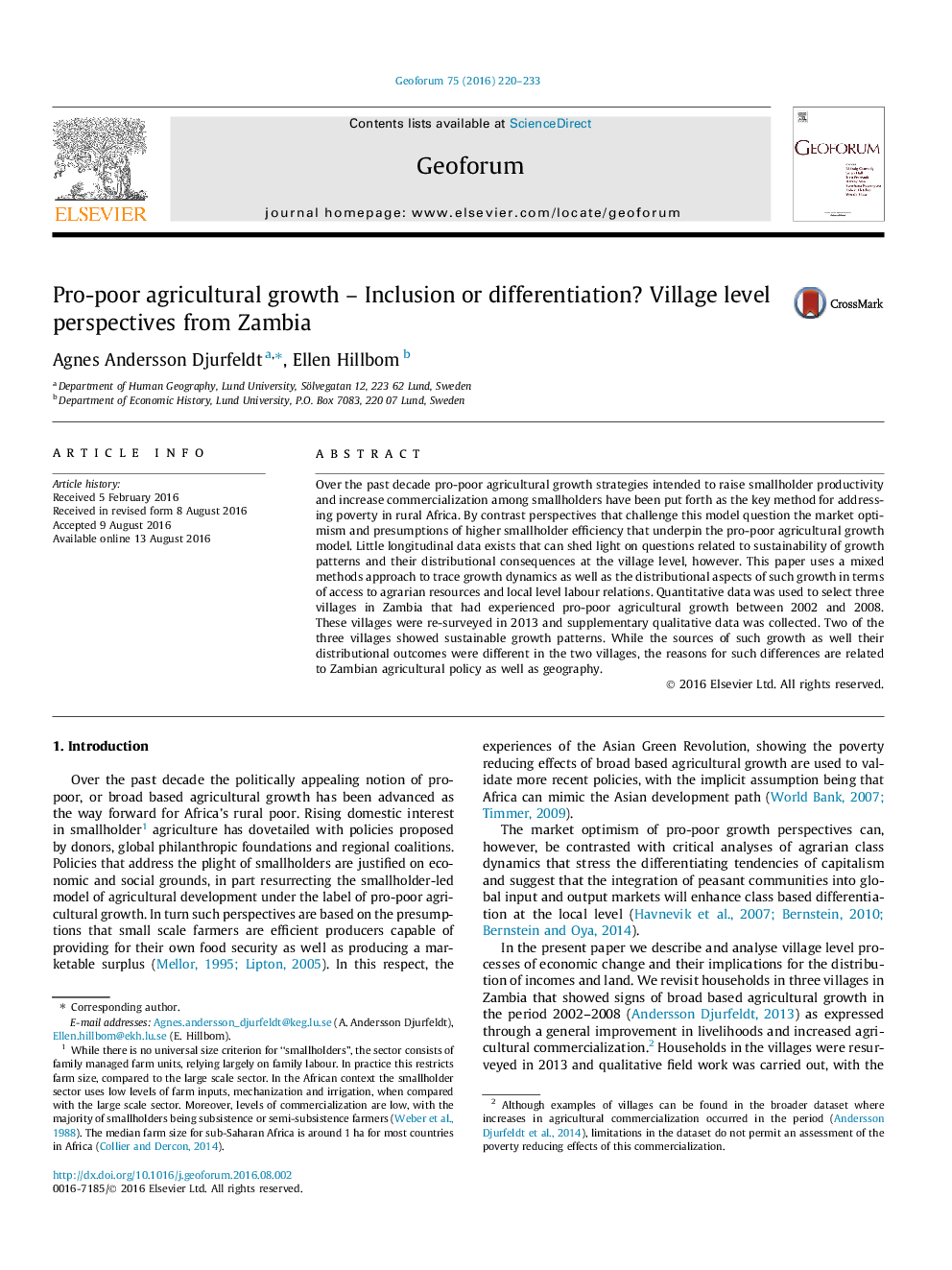| کد مقاله | کد نشریه | سال انتشار | مقاله انگلیسی | نسخه تمام متن |
|---|---|---|---|---|
| 5073369 | 1477114 | 2016 | 14 صفحه PDF | دانلود رایگان |
عنوان انگلیسی مقاله ISI
Pro-poor agricultural growth - Inclusion or differentiation? Village level perspectives from Zambia
ترجمه فارسی عنوان
رشد اقتصادی طرفدار فقیر - دخالت یا تمایز دیدگاه های سطح روستایی از زامبیا
دانلود مقاله + سفارش ترجمه
دانلود مقاله ISI انگلیسی
رایگان برای ایرانیان
ترجمه چکیده
طی دهه گذشته، استراتژی های رشد اقتصادی طرفدار فقیر که به منظور افزایش بهره وری کوچک و افزایش تجارتی در میان صاحبان سهام کوچک، به عنوان روش اصلی برای رسیدگی به فقر در آفریقای روستایی مطرح شده است. در مقابل دیدگاه هایی که این مدل را به چالش می کشد، خوش بینی بازار و فرضیه های بهره وری کوچکتر مالکان است که مدل رشد کشاورزی طرفدار فقیر را بر عهده دارد. داده های طولی طولانی وجود دارد که می تواند در مورد سوالات مربوط به پایداری الگوهای رشد و پیامدهای توزیع آن در سطح روستا روشن شود. این مقاله از رویکرد ترکیبی برای ردیابی دینامیک رشد و همچنین جنبه های توزیع چنین رشدی از لحاظ دسترسی به منابع کشاورزی و روابط کار محلی استفاده می کند. داده های کمی برای انتخاب سه روستا در زامبیا که در سال های 2002 تا 2008 رشد کشاورزی طرفدار فقرا را تجربه کرده بودند مورد استفاده قرار گرفت. این روستاها در سال 2013 دوباره مورد بازبینی قرار گرفت و اطلاعات کیفی تکمیلی جمع آوری شد. دو منطقه از سه روستا الگوهای رشد پایدار را نشان دادند. در حالی که منابع این رشد و همچنین نتایج توزیع آنها در دو روستا متفاوت بود، دلایل این تفاوت ها به سیاست زراعتی کشاورزی و همچنین جغرافیا مربوط می شود.
موضوعات مرتبط
علوم انسانی و اجتماعی
اقتصاد، اقتصادسنجی و امور مالی
اقتصاد و اقتصادسنجی
چکیده انگلیسی
Over the past decade pro-poor agricultural growth strategies intended to raise smallholder productivity and increase commercialization among smallholders have been put forth as the key method for addressing poverty in rural Africa. By contrast perspectives that challenge this model question the market optimism and presumptions of higher smallholder efficiency that underpin the pro-poor agricultural growth model. Little longitudinal data exists that can shed light on questions related to sustainability of growth patterns and their distributional consequences at the village level, however. This paper uses a mixed methods approach to trace growth dynamics as well as the distributional aspects of such growth in terms of access to agrarian resources and local level labour relations. Quantitative data was used to select three villages in Zambia that had experienced pro-poor agricultural growth between 2002 and 2008. These villages were re-surveyed in 2013 and supplementary qualitative data was collected. Two of the three villages showed sustainable growth patterns. While the sources of such growth as well their distributional outcomes were different in the two villages, the reasons for such differences are related to Zambian agricultural policy as well as geography.
ناشر
Database: Elsevier - ScienceDirect (ساینس دایرکت)
Journal: Geoforum - Volume 75, October 2016, Pages 220-233
Journal: Geoforum - Volume 75, October 2016, Pages 220-233
نویسندگان
Agnes Andersson Djurfeldt, Ellen Hillbom,
